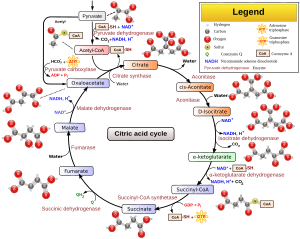Krebs cycle facts for kids
The Krebs cycle is a super important process inside your cells! It's named after a scientist named Hans Krebs. You might also hear it called the citric acid cycle or the TCA cycle.
This cycle is a set of chemical reactions that helps living things that use oxygen (called aerobic organisms) make energy. It's a key part of how your body works and probably developed very early in life's history.
The Krebs cycle happens right after something called the link reaction. It creates special ingredients (hydrogen and electrons) that are needed for the next step, the electron transport chain. All of this takes place inside tiny parts of your cells called mitochondria, which are like your cell's power plants!
What the Krebs Cycle Does
The Krebs cycle is like a spinning wheel of chemical reactions. It helps your body turn food into energy. This energy is stored in a special molecule called ATP. The cycle also produces CO2, which you breathe out.
Here's a quick look at what happens in one spin of the cycle:
- Two molecules of carbon dioxide are released.
- One molecule of GTP (another energy-carrying molecule) is made.
- Three molecules of NAD+ pick up hydrogen, becoming NADH.
- One molecule of FAD picks up hydrogen, becoming FADH2.
Making Energy from Glucose
When your body breaks down a sugar molecule called glucose, it creates two smaller molecules called acetyl-CoA. Because of this, the Krebs cycle needs to run two times for every glucose molecule.
After two full cycles, here's what you get:
- Two ATP molecules (for energy)
- Six NADH molecules (carry electrons)
- Two FADH2 molecules (carry electrons)
- Four CO2 molecules (which you breathe out)
These NADH and FADH2 molecules are super important. They carry the hydrogen and electrons to the electron transport chain, where most of the cell's energy is actually made!
Related Pages
See Also
 In Spanish: Ciclo de Krebs para niños
In Spanish: Ciclo de Krebs para niños


